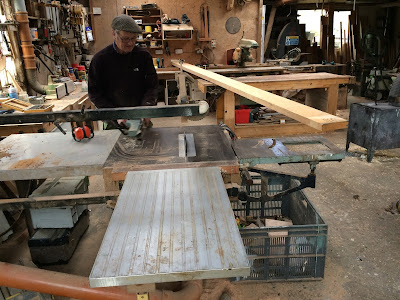One of the great delights in my boatbuilding activities is visiting my ancient friend in his Dragon's Workshop half way up a mountain a few miles from my house. Forget your dinky clamps when you can dog your stick down with one of these fellows, hand-forged in Sheffield. A whack on top with the heavy hammer secures it, a whack on the side and it's free.
I'm well past the stage of wondering whether to rig the Kotik as sloop or yawl, as discussed briefly, here: Hull Coming Along
I'm sure that the decision to go with the sloop is correct, as at 21 feet overall the Kotik is still a very small boat. Upwards of 24 feet and with a built-in trunk for the rudder stock would be a different story, because you would have positive steering and a more workable stern deck. That would of course entail a complete redesign, or going with Albert Strange.
The next step was to decide how to build the mast.
By far the strongest and simplest mast would be a rectangular box section, as described by L Francs Herreshoff in Sensible Cruising Designs, but of course it's not suitable for gaff/gunter rig. This left the birds mouth method, akin to making a staved barrel with extra bits, or back to basics with a solid single piece or a hollow two piece spar.
Over the years I've read a lot about the birds mouth method and the drawings received from Iain Oughtred included detailed dimensions for the smaller Wee Seal design, which could have been scaled up. I can see the attraction if one has to use a lot of small sectioned stock, but less appealing if you are able to source some good stock. After a lot of thought the simplicity and certainty in the hollow two part method won the day and the following sketch resulted:
Some months ago a nice piece of Sitka Spruce arrived from the South of England and with the weather too cold and wet for working on the hull it's time for spar making. With a good fire in the stove conditions were ideal.
The first task was to split the stick, twenty feet by eight inches by two inches, lengthwise. There wasn't sufficient space to use the big machine, seen behind the stove in the above image, so we had to use the table saw, which was just possible when John cut a hole in the wall.
There followed an hour or so of thicknessing, again using a small portable machine.
This all goes to show that with care you can handle large sections and lengths with smaller machines.
Afternoon on day one involved starting the hollowing out process. By this time I'd decided to extend the hollow section through the foot length marked "solid" on the sketch, as I don't think pressure from the gaff jaws will be all that great.
We both hate routers and John drew the short straw, on the basis that a litre of the Grouse would restore him later.
There followed a couple of hours of work with one of those ancient planes that people find in antique shops and hang on their cottage walls, this one once the property of the man who trained the man who trained John's grandfather, or something like that. (I find it difficult to keep up with the prehistory of Derbyshire.)
First, having sharpened the blade on a stone that arrived here shortly after the American War of Independence Mr H applied principles developed by Isaac Newton to assemble and adjust it (hitting it with a hammer.)
To my astonishment I found that even an old office worker could make a passable job of cleaning out the ridges left behind by the router.














No comments:
Post a Comment